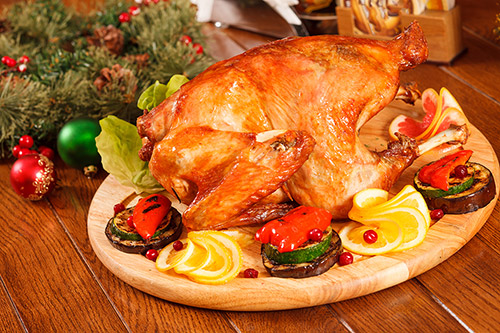Turkey is a mainstay of the Thanksgiving dinner. But it’s not necessarily the best-tasting beast around, nor the cheapest. So how did turkey come to monopolize the holiday?
On Christmas, most of us will sit down to feast on a turkey dinner. How did we end up with the tradition of eating turkeys during the holidays?
Turkeys were fresh, affordable, and big enough to feed a crowd. Around the world, people have long preferred large poultry for celebrations because the birds could be slaughtered without a huge economic sacrifice.
 Cows were more useful alive than dead, and commercial beef wasn’t widely available until the late 19th century. Chicken was more highly regarded than it is today, but rooster meat was tough, and hens were valuable as long as they laid eggs.
Cows were more useful alive than dead, and commercial beef wasn’t widely available until the late 19th century. Chicken was more highly regarded than it is today, but rooster meat was tough, and hens were valuable as long as they laid eggs.
Venison would have been another option, especially during the 17th and 18th centuries, though it would have required you to hunt for your Christmas meal. There was plenty of ham or brined pork around, but it wasn’t considered fit for special occasions. Eating turkey was also in keeping with British holiday customs that had been imported to the New World.
Among the big birds, turkey was ideal for a feast. New born turkeys would spend about seven months eating insects and worms on the farm, growing to about 10 pounds by Christmas . They were cheaper than geese, which were more difficult to raise, and cheaper by the pound than chickens. Cost was an important factor for holiday shoppers, because people weren’t necessarily preparing just one meal; Christmas was the time to bake meat and other types of pies that could last through the coming months.
Although the tradition of turkey is most widely appreciated in the USA, it has become a staple addition to the dining table of families from all around the world.
Most holiday turkeys are stuffed with a bread-based mixture and roasted. Sage is the traditional herb added to the stuffing (also called dressing if NOT cooked inside the bird), along with chopped celery, carrots, and onions. Other ingredients, such as chopped chestnuts or other tree nuts, crumbled sausage or bacon, cranberries, raisins, or apples, may be added to stuffing. Deep-fried turkey is rising in popularity due to its shorter preparation time, but carries safety risks.






